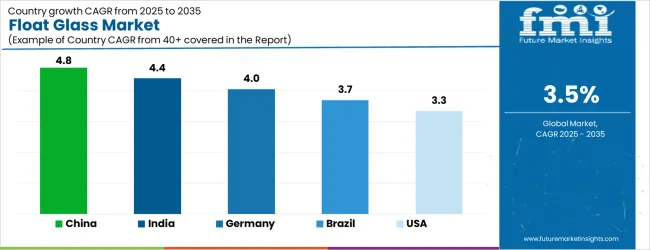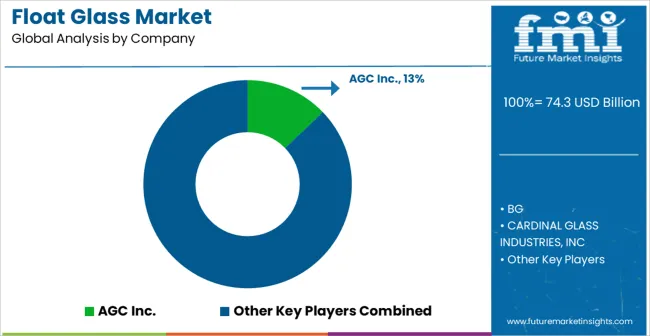The Float Glass Market is estimated to be valued at USD 74.3 billion in 2025 and is projected to reach USD 105.0 billion by 2035, registering a compound annual growth rate (CAGR) of 3.5% over the forecast period.

| Metric | Value |
|---|---|
| Float Glass Market Estimated Value in (2025 E) | USD 74.3 billion |
| Float Glass Market Forecast Value in (2035 F) | USD 105.0 billion |
| Forecast CAGR (2025 to 2035) | 3.5% |
The Float Glass market is experiencing steady growth, driven by increasing demand from the construction, automotive, and architectural sectors. The adoption of energy-efficient and high-performance glass solutions is being fueled by the rising need for sustainable building materials, improved thermal insulation, and enhanced aesthetic appeal in modern construction. Technological advancements in glass manufacturing processes, including automated float lines and precision annealing techniques, have enhanced product quality, reduced defects, and increased production efficiency.
Growing urbanization, infrastructure development, and the expansion of commercial and residential construction projects are supporting the market’s growth trajectory. Environmental regulations and energy conservation standards are also promoting the use of high-quality float glass that improves building performance while minimizing energy consumption.
Integration with smart building systems and the increasing demand for multifunctional glass, such as low-emissivity and laminated options, are further shaping market trends As manufacturers continue to innovate in glass processing and coating technologies, the market is expected to witness sustained expansion, with rising adoption across emerging and developed regions driving long-term growth.
The float glass market is segmented by raw material, end use, and geographic regions. By raw material, float glass market is divided into Sand, Soda Ash, Limestone, Dolomite, and Others (Colour Additives, Etc.). In terms of end use, float glass market is classified into Construction, Automotive, PCV, LCV, HCV, Commercial, Industrial, Residential, Infrastructural, Solar Glass, and Others (Furniture, Etc.). Regionally, the float glass industry is classified into North America, Latin America, Western Europe, Eastern Europe, Balkan & Baltic Countries, Russia & Belarus, Central Asia, East Asia, South Asia & Pacific, and the Middle East & Africa.

The sand segment is projected to hold 36.4% of the Float Glass market revenue in 2025, establishing it as the leading raw material. Growth in this segment is being driven by the superior quality and purity of sand required for producing high-performance float glass. High silica content ensures optimal transparency, thermal stability, and mechanical strength, which are critical for both construction and automotive applications.
Advances in sand refining and processing techniques have enhanced uniformity, reduced impurities, and improved consistency in float glass production. The ability to achieve precise chemical composition through controlled sand selection allows manufacturers to produce glass with tailored optical and structural properties. With increasing demand for energy-efficient buildings and high-quality architectural glass, the sand segment remains indispensable in the supply chain.
Consistent quality, availability, and cost-effectiveness of high-grade silica sand are strengthening its market position As construction and infrastructure projects continue to expand globally, the sand segment is expected to maintain its leadership, driven by growing requirements for durable and high-performance float glass.

The construction end-use segment is anticipated to account for 41.8% of the Float Glass market revenue in 2025, making it the largest application area. Growth is being driven by the increasing demand for residential, commercial, and industrial buildings that require high-quality glass for facades, windows, and interior applications. Float glass provides structural strength, aesthetic appeal, and energy efficiency, aligning with modern building standards and sustainable construction practices.
Technological advancements in coatings, laminations, and tempered processing have enhanced safety, durability, and thermal performance, further driving adoption in the construction sector. Urbanization, infrastructure development, and smart city initiatives have increased the need for versatile glass solutions that support innovative architectural designs.
Regulatory emphasis on energy efficiency and green building certifications has also contributed to the rising adoption of float glass in construction projects As demand for high-performance and multifunctional glass solutions continues to rise, the construction segment is expected to remain the leading end-use industry, supporting long-term market growth and innovation in glass applications.
The float glass manufacturing process is named after the glass manufacturer Alastair Pilkington and hence, is also known as the Pilkington process. Float glass is manufactured by floating molten glass on a bed of molten metals, such as tin, lead and various low melting point alloys. Float glass is a sheet of glass and with the molten glass method, the resultant sheet possesses a good flat surface and uniform thickness.
Most soda-lime glass are float glass and some quantities of flat panel display glass and speciality borosilicate are also made by the float glass process. Common raw materials used for the manufacturing of float glass are soda ash (sodium carbonate), sand, limestone, salt cake (sodium sulphate) and dolomite. Other ingredients may be used as refining, colouring agents or for required changes in the chemical and physical properties of the glass.
Float glass is usually manufactured in batch process and its hardness and rigidness along with fact that it is a waterproof and lightweight insulator make it attractive among all end use applications in the global market.
Float glass is increasingly being used in windows and doors in the construction industry, particularly for windows and doors made of glass. It is finding a variety of applications, such as windshields, windows and mirrors, in the automotive industry.

| Country | CAGR |
|---|---|
| China | 4.8% |
| India | 4.4% |
| Germany | 4.0% |
| Brazil | 3.7% |
| USA | 3.3% |
| UK | 3.0% |
| Japan | 2.6% |
The Float Glass Market is expected to register a CAGR of 3.5% during the forecast period, exhibiting varied country level momentum. China leads with the highest CAGR of 4.8%, followed by India at 4.4%. Developed markets such as Germany, France, and the UK continue to expand steadily, while the USA is likely to grow at consistent rates. Japan posts the lowest CAGR at 2.6%, yet still underscores a broadly positive trajectory for the global Float Glass Market. In 2024, Germany held a dominant revenue in the Western Europe market and is expected to grow with a CAGR of 4.0%. The USA Float Glass Market is estimated to be valued at USD 27.2 billion in 2025 and is anticipated to reach a valuation of USD 27.2 billion by 2035. Sales are projected to rise at a CAGR of 0.0% over the forecast period between 2025 and 2035. While Japan and South Korea markets are estimated to be valued at USD 3.5 billion and USD 2.2 billion respectively in 2025.

| Item | Value |
|---|---|
| Quantitative Units | USD 74.3 Billion |
| Raw Material | Sand, Soda Ash, Limestone, Dolomite, and Others (Colour Additives, Etc.) |
| End Use | Construction, Automotive, PCV, LCV, HCV, Commercial, Industrial, Residential, Infrastructural, Solar Glass, and Others (Furniture, Etc.) |
| Regions Covered | North America, Europe, Asia-Pacific, Latin America, Middle East & Africa |
| Country Covered | United States, Canada, Germany, France, United Kingdom, China, Japan, India, Brazil, South Africa |
| Key Companies Profiled | AGC Inc., BG, CARDINAL GLASS INDUSTRIES, INC, China Glass Holding, China Luoyang Float Glass Group Co., Ltd., Flat Glass Group Co., Ltd, Fuyao Group, Guardian Industries Holdings, Kibing Group, Nippon Sheet Glass Co., Ltd, PRESS GLASS Holding SA, PT Mulia Industrindo Tbk, Saint-Gobain, SCHOTT, Şişecam, and Taiwan Glass Ind. Corp. |
The global float glass market is estimated to be valued at USD 74.3 billion in 2025.
The market size for the float glass market is projected to reach USD 105.0 billion by 2035.
The float glass market is expected to grow at a 3.5% CAGR between 2025 and 2035.
The key product types in float glass market are sand, soda ash, limestone, dolomite and others (colour additives, etc.).
In terms of end use, construction segment to command 41.8% share in the float glass market in 2025.






Our Research Products

The "Full Research Suite" delivers actionable market intel, deep dives on markets or technologies, so clients act faster, cut risk, and unlock growth.

The Leaderboard benchmarks and ranks top vendors, classifying them as Established Leaders, Leading Challengers, or Disruptors & Challengers.

Locates where complements amplify value and substitutes erode it, forecasting net impact by horizon

We deliver granular, decision-grade intel: market sizing, 5-year forecasts, pricing, adoption, usage, revenue, and operational KPIs—plus competitor tracking, regulation, and value chains—across 60 countries broadly.

Spot the shifts before they hit your P&L. We track inflection points, adoption curves, pricing moves, and ecosystem plays to show where demand is heading, why it is changing, and what to do next across high-growth markets and disruptive tech

Real-time reads of user behavior. We track shifting priorities, perceptions of today’s and next-gen services, and provider experience, then pace how fast tech moves from trial to adoption, blending buyer, consumer, and channel inputs with social signals (#WhySwitch, #UX).

Partner with our analyst team to build a custom report designed around your business priorities. From analysing market trends to assessing competitors or crafting bespoke datasets, we tailor insights to your needs.
Supplier Intelligence
Discovery & Profiling
Capacity & Footprint
Performance & Risk
Compliance & Governance
Commercial Readiness
Who Supplies Whom
Scorecards & Shortlists
Playbooks & Docs
Category Intelligence
Definition & Scope
Demand & Use Cases
Cost Drivers
Market Structure
Supply Chain Map
Trade & Policy
Operating Norms
Deliverables
Buyer Intelligence
Account Basics
Spend & Scope
Procurement Model
Vendor Requirements
Terms & Policies
Entry Strategy
Pain Points & Triggers
Outputs
Pricing Analysis
Benchmarks
Trends
Should-Cost
Indexation
Landed Cost
Commercial Terms
Deliverables
Brand Analysis
Positioning & Value Prop
Share & Presence
Customer Evidence
Go-to-Market
Digital & Reputation
Compliance & Trust
KPIs & Gaps
Outputs
Full Research Suite comprises of:
Market outlook & trends analysis
Interviews & case studies
Strategic recommendations
Vendor profiles & capabilities analysis
5-year forecasts
8 regions and 60+ country-level data splits
Market segment data splits
12 months of continuous data updates
DELIVERED AS:
PDF EXCEL ONLINE
Floating Microelectrode Array (FMA) Market Size and Share Forecast Outlook 2025 to 2035
Floating Docks Market Size and Share Forecast Outlook 2025 to 2035
Floating Fountains Market Size and Share Forecast Outlook 2025 to 2035
Float Level Switches Market Size and Share Forecast Outlook 2025 to 2035
Floating Valve Trays Market Size and Share Forecast Outlook 2025 to 2035
Floating Solar PV Market Size and Share Forecast Outlook 2025 to 2035
Floating Covers Market Size and Share Forecast Outlook 2025 to 2035
Floating Offshore Wind Energy Market Size and Share Forecast Outlook 2025 to 2035
Floating Power Plant Market Growth – Trends & Forecast 2025 to 2035
Floating Hotel Industry Analysis by Type, by End User, by Tourist Type, by Booking Channel, and by Region – Forecast for 2025-2035
Market Share Distribution Among Floating Hotel Providers
Floating LNG Power Vessel Market Growth – Trends & Forecast 2024-2034
Dog Float Market Size and Share Forecast Outlook 2025 to 2035
Level Floats Market Size and Share Forecast Outlook 2025 to 2035
Solar Floating Pool Lights Market Insights – Trends, Demand & Growth 2025-2035
Ballistic Floatation Vest Market Size and Share Forecast Outlook 2025 to 2035
Glass Rolling Forming Machine Market Size and Share Forecast Outlook 2025 to 2035
Glass Liquor Bottle Market Size and Share Forecast Outlook 2025 to 2035
Glass Bottles Market Forecast and Outlook 2025 to 2035
Glass Laser Engraving Machine Market Size and Share Forecast Outlook 2025 to 2035

Thank you!
You will receive an email from our Business Development Manager. Please be sure to check your SPAM/JUNK folder too.
Chat With
MaRIA